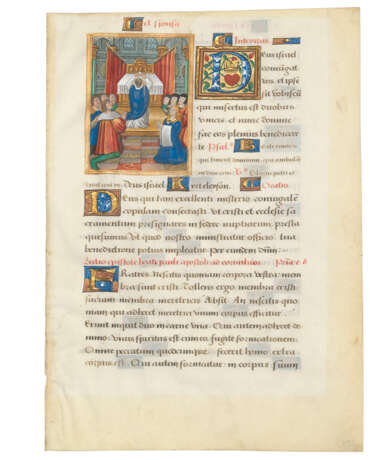ID 794395
Lot 18 | Étienne Colaud (fl. c.1512-41)
Valeur estimée
£ 5 000 – 8 000
A Wedding Mass, miniature on a leaf from the Missal of Guy de Baudreuil [Paris, 1520]
A handsome leaf depicting a Wedding Mass with the Celebration of the Eucharist, from what would have been an imposing Missal made for Guy de Baudreuil, patron of the arts and commendatory abbot of the monastery of Saint-Martin-aux-Bois.
286 x 208mm. The initial 'D' opens the introit for a Wedding Mass: 'Deus Israel coniungat vos'. 26 lines in a French bâtarde with headers and rubrics in red, 1- and 2-line initials and line fillers in gold on blue and red grounds with white infilling, one 4-line initial in blue with white infilling on a floral background with a crowned heart, modern foliation '133' in pencil in lower margin (light marginal staining). Mounted (light marginal staining).
Provenance:
This leaf and thirteen others (see sister leaves below) come from a dismembered Missal most likely made for Guy de Baudreuil, a celebrated patron of the arts and commendatory abbot of the ancient monastery of Saint-Martin-aux-Bois from 1491⁄2 to 1530. According to Peterson and Stones ('The Book Goes Public,' Carnegie Magazine, March/April 1989, p.31), the Missal originally comprised 135 leaves with 48 miniatures. Crowned red hearts within the initials decorated with white spiral motifs, as in the present leaf, appear in numerous sister leaves and identify the Missal as Guy de Baudreuil's commission (see Les Enluminures, Catalogue 18, p.162). We owe to Guy the patronage of a number of works, including the beautiful choir stalls in the Abbey of Saint-Martin-aux-Bois, and a lavish tapestry figuring Minerva and showing his arms, crowned red hearts and spiralling banderoles echoing those found in the sister leaves of the Missal (see France 1500. Entre Moyen Age et Renaissance, 2010, pp. 331-332, no 171). A tapestry fragment undoubtedly from Saint-Martin-aux-Bois with his arms is among four others now at the Metropolitan Museum of Art (see S. Cavallo, Medieval Tapestries at the Metropolitan Museum of Art, 1993, cat. no 24). Apart from being a patron of the arts, Guy de Baudreuil was an important historical figure: jurist, counselor for the House of Savoy, and for Louise de Savoie, mother of François of Angoulême, future Francis I, King of France.
Sister leaves:
1. Presentation of the Virgin in the Temple; 2. The Crowned Virgin and Child as 'The Apocalyptic Woman Clothed in the Sun'; 3. The Annunciation; and 4. St Martha (Dallas Public Library, Gift of Virginia Lazenby O'Hara).
5. St Nicholas (present location unknown)
6. Assumption of the Virgin (Private Collection; formerly Les Enluminures, Catalogue 15, no 33)
7. Transfiguration (Pittsburgh, Carnegie Museum of Art, inv. no. 80.29)
8. Funeral Scene, Office of the Dead (present location unknown, formerly Maggs Bros., 2002)
9. The Birth of the Virgin and 10. Christ and the Apostles before the Sea of Galilee (Private Collection, USA)
11. St Catherine (Private Collection, USA)
12. Mary Magdalene (Les Enluminures)
13. Holy Trinity (Private Collection, Michigan, USA)
Illumination:
The style of the manuscript places it in the orbit of Étienne Colaud and his workshop, active in Paris from c.1512-1536. Colaud headed a large enterprise that illuminated a great number of classical, secular, and liturgical texts for several great lords, prelates, and the King of France himself. It is likely that he trained within the workshop of Jean Pichore (C. Zöhl, Jean Pichore: Buchmaler, Graphiker und Verleger in Paris um 1500, 2004). Marie-Blanche Cousseau was able to attribute to his own hand some twenty manuscripts on the basis of a Book of Hours bearing his name (M-B.Cousseau, Étienne Colaud et l’enluminure parisienne sous le règne de François Ier, 2016). A portrait of Guy de Baudreuil with his coat of arms attributed to an artist of Colaud’s circle appears in the presentation scene in a copy of Petrarch's Life of Hannibal translated into French by Simon Bourgoing (Paris, BnF, MS NAF 25165). The strongly modelled faces of kneeling figures in the present miniature are typical of Colaud’s style, such as those found in the Roman de Palamon et Arcita whose decoration was divided between the workshop master and his associates (Paris, BnF, Arsenal, MS 5116).
Special notice
This lot has been imported from outside of the UK for sale and placed under the Temporary Admission regime. Import VAT is payable at 5% on the hammer price. VAT at 20% will be added to the buyer’s premium but will not be shown separately on our invoice.
| Artiste: | Étienne Colaud (Collault) (1542) |
|---|---|
| Lieu d'origine: | Europe de l'Ouest, France, Europe |
| Catégorie maison de vente aux enchères: | Manuscrits médiévaux et de la Renaissance |
| Artiste: | Étienne Colaud (Collault) (1542) |
|---|---|
| Lieu d'origine: | Europe de l'Ouest, France, Europe |
| Catégorie maison de vente aux enchères: | Manuscrits médiévaux et de la Renaissance |
| Adresse de l'enchère |
CHRISTIE'S 8 King Street, St. James's SW1Y 6QT London Royaume-Uni | |
|---|---|---|
| Aperçu |
| |
| Téléphone | +44 (0)20 7839 9060 | |
| Commission | see on Website | |
| Conditions d'utilisation | Conditions d'utilisation |



